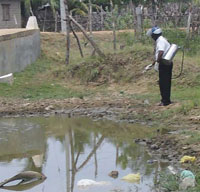9.3 Larviciding
Larviciding refers to the use of chemicals or biological agents or toxins to kill mosquito larvae. Water collections that cannot be managed by environmental control measures can be dealt with by larvicides. Like environmental control measures, the success of larvicides will depend on the identification of mosquito breeding sites and their distribution in the area, followed by sustained weekly spraying of chemicals (Figure 9.9). Larvicides should be applied in conjunction with other environmental control measures.

A chemical called Temephos (sold under the trade name Abate) has been the most widely used mosquito larvicide worldwide and in Ethiopia. Temephos is highly active against the nervous system of mosquito larvae and other aquatic insects, and a relatively low dosage can kill them before they reach the adult stage. Its toxicity (ability to poison) fish, birds, humans and other mammals is very low. Its low toxicity to non-target organisms and low effective dosage make Temephos the most appropriate larvicide in many situations. It is recommended for the control of mosquito larvae in drinking-water and in areas where fish, birds and mammals may come into contact with it.
According to the current Ethiopian national strategy for vector control, health posts will be supplied with spray pumps and Temephos, and you are expected to mobilise the community to undertake larviciding when necessary. Unlike indoor residual spraying (described in Study Session 10), larviciding requires little technical skill and therefore you can train community members to spray Temephos into breeding sites under your supervision and technical support. The instructions are given in Box 9.1.
Box 9.1 Preparations for spraying Temephos
- Estimate (in square metres) the size of the breeding sites positive for Anopheles larvae, which cannot be dealt with by environmental management;
- Use a disposable syringe to measure 8 ml of Temephos (Abate) and mix it into 8 litres (one spray pump) of water;
- One spray pump should cover an area of water of 320 square metres;
- Pump by hand 60 times to produce the necessary level of air pressure in the sprayer;
- Use trained community volunteers to spray the chemical onto the water in the breeding site;
- Keep good records of the accomplished activities.
9.2.4 Common vector breeding grounds in Ethiopia
